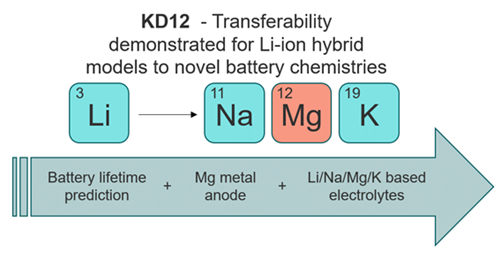The changing battery landscape requires advanced models that go beyond lithium-ion technology to continue the progress and investigation. The BIG-MAP project has devised innovative methodologies succeed on the adaptation of models from lithium-ion to emerging systems like sodium or magnesium-based batteries, overcoming lithium-ion limitations and promoting sustainable energy storage solutions. It includes machine learning models for predicting battery lifespan and customized experimental methods to test their applicability across different systems.

Lithium and sodium battery lifetime generator using regression approach and electrode embedding
Many lifetime prediction models rely on time series forecasting using historical cycling data, but face challenges like error accumulation and limited historical context. To address these issues, we propose a regression-based approach integrating domain knowledge for adaptable and transferable battery lifetime forecasting. Our method aims to provide precise estimations of cycle numbers for specific State of Health (SOH) percentiles, improving understanding of battery lifetime prognosis. With a meticulously curated database and advanced post-processing techniques, our model demonstrates exceptional forecasting precision across diverse electrodes and input parameters, eliminating the need for separate methodologies for different battery technologies. Multiple simulations efficiently generate SOH evolution, minimizing errors and showcasing the model's proficiency in accurately understanding capacity decay and forecasting in various scenarios for both lithium-ion and sodium-ion cells.
Deep neural network for battery capacity fade prediction
Similar to the preceding battery lifetime prediction model, this model is intended to cater to various NMC cathode materials, encompassing diverse coatings, doping methodologies, and synthesis conditions. The batteries undergo testing under fluctuating temperature conditions.
From Li-ion to Mg metal anode-organic battery: Magnesium (Mg) metal batteries, known for their high capacity, face challenges due to limited practical electrolytes and cathode materials. While progress has been made in Mg electrolytes, organic cathode materials offer promising adaptability. We developed an Mg metal anode setup with an organic cathode using conjugated carbonyl active materials. Our configuration included a half-cell setup with an Mg metal foil anode, organic working electrode, and specific electrolyte. We tested two active materials: anthraquinone-based poly (anthraquinonyl sulfide) (PAQS) and benzoquinone-based poly (hydroquinonyl-benzoquinonyl sulfide) (PHBQS), both operating through carbonyl reduction.
Experimental approaches towards transferability to novel battery chemistries
The experimental pathway towards transferability in battery technology is complex due to numerous parameters and compatibility issues between electrode and electrolyte components. Despite challenges, an experimental plan was devised, starting from standard Li-ion technology and gradually transitioning to new chemistries while maintaining parameter consistency. The positive electrode, LiNiO2, with its intercalation properties, was retained, while a common activated carbon negative electrode was employed due to its capacitive redox mechanism. Contingency plans were made to focus on monovalent charge carrier ions (Li, Na, K) with a standardized electrolyte formulation (1M APF6 in EC/EMC) to address adhesion issues with laminated electrodes. Cycling tests revealed significant capacity fading, particularly with KPF6 electrolyte. Operando X-ray diffraction experiments at ALBA synchrotron confirmed the involvement of Na and K in the redox mechanism, despite the presence of Li+ ions in the electrolyte.
Electrolyte systems (Li/Na/Mg) based on AIMD and machine learning simulations
We investigated electrolyte systems involving NaPF6 and Mg(ClO4)2 in EC/EMC = 3:7 (LP57), extending beyond Li-ion batteries with LiPF6 electrolytes. While LiPF6 offers high conductivity and stability, challenges like moisture susceptibility persist. Recent research suggests improving LiPF6 electrolytes with specific solvents and co-solvents. Understanding LiPF6 in solvents, including metal cation solvation properties, is crucial for optimizing battery performance and exploring alternative electrolytes, applicable to Na and Mg batteries as well. Atomic-scale simulations via ab initio molecular dynamics (AIMD) explored solvation properties of Li, Na, and Mg cations, aiding insights into cation diffusion within electrolytes. Simulation results revealed distinct solvation structures for LiPF6, NaPF6, and Mg(ClO4)2 electrolytes, with stable trajectories providing insights into cation-solvent interactions.